|
 Prehistoric China:
Prehistoric China:
The Neolithic period began in
China about 12,000 B.C. However, good evidence of Neolithic
settlements exists from only about 4,000 B.C. The Neolithic
lasted until about 2,000 B.C. (1)
Xia Dynasty: c. 2,100-1,800 B.C.
(1)
Legend says
that this dynasty began when a man named Yu drained the waters of the
flood (a parallel story to the experiences of Noah). He became the first
king of the Hsia Dynasty.
Shang Dynasty: c. 1,700-1,027 B.C.
(1)
Article: (Dec, 2012).
Sci-news.com
'Engraved Stone Dating Back 30.000 BC Unearthed
in China'.
Chinese archaeologists have discovered a stunning 30,000-year-old
engraved stone artefact in a collection of stone tools unearthed at the
Palaeolithic site of Shuidonggou in 1980.
we believe that the incisions were made by intentional
behaviour. Although we cannot be sure of the function of these
incisions, the straight shape of each line shows that it was
incised once over a short time interval without repeated
cutting, implying the possibility of counting or recording at
that time.� �Furthermore, creation of such an engraved object
may indicate the possible existence of complex communicative
systems such as language,� said Dr Peng, who reported the
discovery in the Chinese Science Bulletin. �In addition to the
engraved stone artefact, one ostrich egg bead was unearthed'.
(Link
to Full Article)
Featured Items:
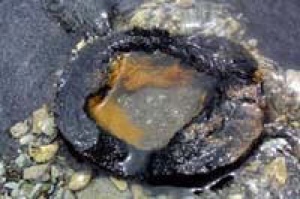 The Baigong Cave in China
is
the location of numerous ancient underground 'metal pipes' that were
discovered in the beginning of the 20th century. Traditional
science has provided one or two explanations for their presence,
but as yet there is no definite answer as to how or why the
pipes exist where they do, as they run through the ground and
even into the nearby lake. The Baigong Cave in China
is
the location of numerous ancient underground 'metal pipes' that were
discovered in the beginning of the 20th century. Traditional
science has provided one or two explanations for their presence,
but as yet there is no definite answer as to how or why the
pipes exist where they do, as they run through the ground and
even into the nearby lake.
There is no
evidence of an associated pyramid, as is normally reported, but
the idea that they are fossilised tree roots remains
unsatisfactory making the Baigong pipes one of todays more
interesting modern O.O.P.Arts.
(More
about the Baigong Pipes)
| The Longyou Caves
(Grottos): |
These 24
hand-carved caves were only discovered late in the 20th century.
Until then they were thought of as natural reservoirs within which
villagers used to collect fish. In 1992, a local villager decided to
pump one of the caves of its water, revealing the startling immense
carved chambers running as deep as 30m and covered with a beautiful
pattern of chisel marks on all the walls and ceilings.
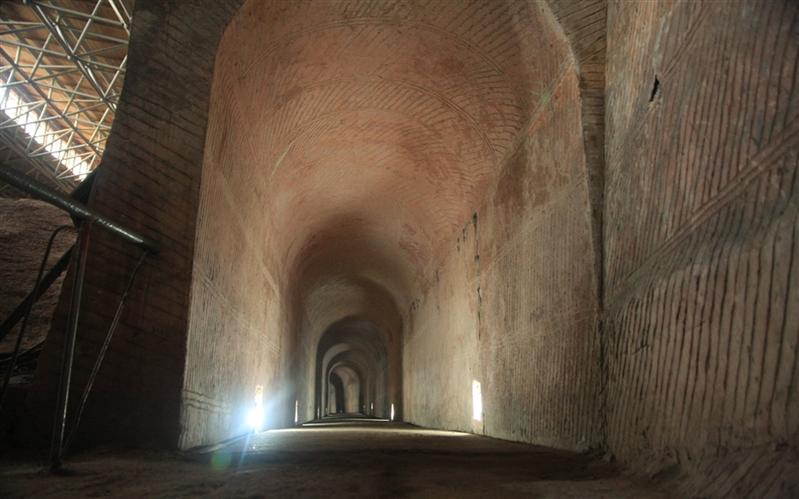
Although the
overall excavation involved almost a million cubic metres of
stone, there is no historical record of them or evidence of the
removed stone.
Their origin is
a complete mystery.
(More
about the Longyou caves)
| The Chinese
Pyramid Fields: |
Deep within China near the ancient capital
city of Xi'an lies a series of pyramid-mounds virtually unknown outside the country
until last century. The Chinese pyramid fields are
now
recognised as one of the greatest pyramid concentrations in the world.
They have flattened tops, and are therefore more similar in shape to the South
American pyramids than
the pyramids of Egypt.
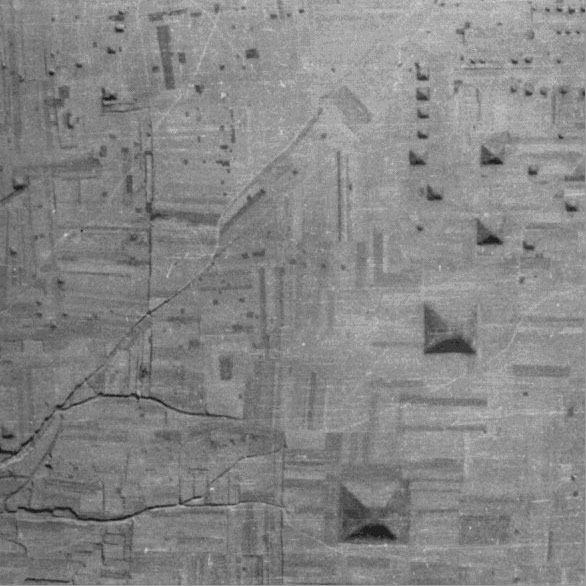
The
image above is of the Ya-sen valley, Xi'an, in which the pyramids were all
orientated cardinally.
Most of the pyramids range
from 20 to 200 ft in height and 50 to 600 feet in width. They are mostly
found in an area of concentration NE of Xi'an and they all
face exactly north, south, east and west. The oldest of these pyramids is
believed to be the tomb of
Qin shi Huangdi, first emperor of the Qin dynasty who
unified China which makes them no older than 2,500 years old.
(More about the Chinese Pyramid Fields)
Chinese Bird-bone Flutes:
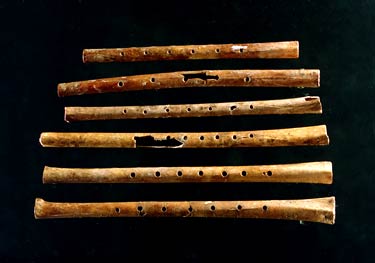 Jiahu:
(A cache over over 30 bird-bone flutes). The 9,000-year-old flutes
are made from hollowed bird bones, and have between 5 and 8 holes.
Remarkably, one of the flutes is still playable. Scientists also
know of a 45,000-year-old, so-called Neanderthal flute made of a
hollow bear bone that was dug up in Slovenia in 1995. The Chinese
flutes are capable not just of single notes but of what we would
class as music (4) Jiahu:
(A cache over over 30 bird-bone flutes). The 9,000-year-old flutes
are made from hollowed bird bones, and have between 5 and 8 holes.
Remarkably, one of the flutes is still playable. Scientists also
know of a 45,000-year-old, so-called Neanderthal flute made of a
hollow bear bone that was dug up in Slovenia in 1995. The Chinese
flutes are capable not just of single notes but of what we would
class as music (4)
The bone flutes excavated
from the Jiahu ruins in Wuyang County of Henan Province is the
earliest wind instrument found so far by Chinese archaeologists. The
flutes dates back over 8,000 years. The largest is about 20 cm long
and 1 cm in diameter, with 7 evenly-distributed sound holes of the
same size. And a handful of such flutes have an extra small hole
beside the last hole.
The making method and process of Jiahu bone
flute are very much similar to those of modern-day Chinese wind
instruments. According to zoologists' research, Jiahu bone flutes
are made with crane ulna bones with the joints at both ends removed.
Some bone flutes still bear the marks carved before hole drilling
for even distribution, indicating the careful calculation Jiahu
people conducted before flute making. The extra small hole on some
flutes has been proved by scientists through tone testing to give
out two variable sounds. Therefore, the hole serves as a tone
adjuster.
The flute reflects the
amazingly high levels of tonality and calculation. Modern musicians
can play the pentatonic-scale tune of
Little Cabbage (Xiao Baicai) on the flute. These facts indicate
that Jiahu people already had the basic ideas about the tone
differences and tried to achieve the pitch accuracy. They also had
rudimentary understanding of the relations between sound pitch and
pipe length.
The discovery of Jiahu bone flutes has
rewritten the history of Chinese music, proving that the
seven-tone scale music was practiced some 8,000 years ago
(7).
(More About Prehistoric Bone Flutes)
Writing:
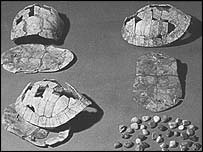 In April 2003 Dr. Garman Harbottle of the
Brookaven National Laboratory in Upton, New York,
and a team of archaeologists at the University of
Science and Technology of China, in Anhui province,
announced that signs carved into what appeared to be
8,600 year-old-tortoise shells may be the earliest
written words. In April 2003 Dr. Garman Harbottle of the
Brookaven National Laboratory in Upton, New York,
and a team of archaeologists at the University of
Science and Technology of China, in Anhui province,
announced that signs carved into what appeared to be
8,600 year-old-tortoise shells may be the earliest
written words.
Other authorities urge caution regarding
the dating of this material. The symbols
may have been recorded in the late Stone Age or
Neolithic Age. The symbols also bear similarities to
the oracle bone script used thousands of years later
during the Shang dynastybut it is unclear whether these symbols
were part of an actual writing system. The BBC
reported:
"The archaeologists
have identified 11 separate symbols inscribed on the
tortoise shells.
"The shells were found
buried with human remains in 24 Neolithic graves
unearthed at Jiahu in Henan province, Western China.
"The site has been
radiocarbon dated to between 6,600-6,200 BC"
(http://news.bbc.co.uk/2/hi/science/nature/2956925.stm)
Article:
(Huffington Post, 2013). Primitive Writing Found on Axe Heads c.
3,000 BC: (Quick
Link)
|
Magnetism.

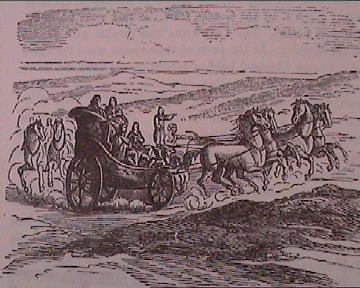
2637 BC - "This date has been conclusively
shown to be the earliest one at which history notes anything resembling
the application of the magnetic influence. It is related that, during
this sixty-first year of the reign of Hoang-ti (Yeou-hioung-che, also
named Koung-fen and Hiuen-yuen), the emperors troops, who were pursuing
the rebelious prince Tcheyeou (Tchi-yeou), lost their way, as well as
the course of the wind, and likewise the sight of their enemy, during
the heavy fogs prevailing in the plains of Tchou-lou. Seeing which,
Hoang-ti constructed a chariot upon which stood erect a prominent female
figure which indicated the four cardinal points, and which always turned
to the south whatever might be the direction of the chariot. Thus he
succeeded in capturing the rebellious prince, who was put to death.
Some say that upon this chariot stood
a needle, to denote the four parts of the world. That, states the French
author writing in 1736, would "indicate the use of a compass, or
something very similar to it ... and it is unfortunate that the device
has not been explained more fully." (3)
1110 BC - Tcheou Koung is said to have at this
date taught the use of the needle and compass to the envoys from
Youa-tchang. "As the ambassadors sent from Cochin China and Tonquin" (Humbolt,
"Cosmos," Vol. V. p. 51) "were about to take their departure2 (which was
in the twenty-second cycle, more than 1040 years BC), "Tcheou-Koung gave
them an instrument which upon one side always turned towards the north
and on the opposite side to the south, the better to direct them upon
their homeward voyage. This instrument was called tchi-nan
(chariot of the south), and it is still the name given to the compass,
which leads to the belief that Tcheou-Koung invented the latter." In his
chapter on "the magnetic needle," Humboldt says the apparatus was called
fse-nan (indicator of the south). (3)
(More
about Magnetism in Prehistory)
|
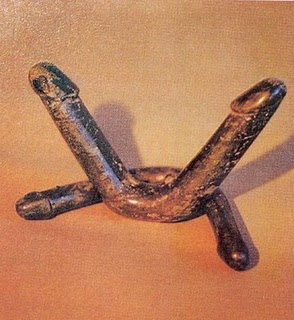
Phallic
representations have been found in China that date back as early as
the New Stone Age, that�s more than 12,000 years ago and most
recently a tomb was uncovered from the Han Dynasty in Xian, China
that was home to a rather interesting collection of phallus (see
right).
|
Article: (ScienceDaily 2005).
Chinese Used Diamonds To
Polish Sapphire-Rich Stone In 2500 BC
Researchers have uncovered strong
evidence that the ancient Chinese used diamonds to grind and polish
ceremonial stone burial axes as long as 6,000 years ago -� and
incredibly, did so with a level of skill difficult to achieve even with
modern polishing techniques.
The work also represents the only
known prehistoric use of sapphire: The stone worked into polished axes
by China's Liangzhu and Sanxingcun cultures around 4000 to 2500 BC has
as its most abundant element the mineral corundum, known as ruby in its
red form and sapphire in all other colors. Most other known prehistoric
artifacts were fashioned from rocks and minerals no harder than quartz.
Peter Lu began the research in 1999,
as a Princeton University undergraduate. He studied four ceremonial
axes, ranging in size from 13 to 22 centimeters, found at the tombs of
wealthy individuals. Three of these axes, dating to the Sanxingcun
culture of 4000 to 3800 BC and the later Liangzhu culture, came from
the Nanjing Museum in China; the fourth, discovered at a Liangzhu
culture site at Zhejiang Yuhang Wujiabu in 1993, dates roughly to 2500
BC.
"What's most amazing about these mottled
brown and grey stones is that they have been polished to a
mirror-like lustre,"
(Click here for full Article)
|
Flight:
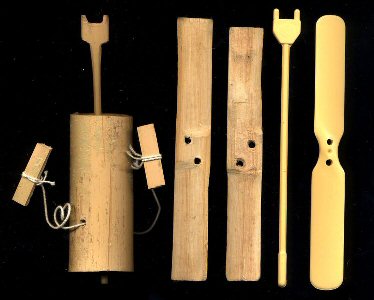
Taketonbo; The "Bamboo dragonfly") is a Chinese
children's toy invented around 400 BC
(4). It essentially consists of a
propeller on a stick, and rolling the stick in the right direction spins the
propeller, causing the toy to "take off" when it is let go of.
(Other
Examples of Ancient Flight)
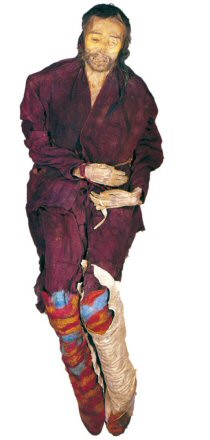
In
the late 1980's, perfectly preserved 3000-year-old mummies began
appearing in a remote Chinese desert. They had long reddish-blond
hair, European features and didn't appear to be the ancestors of
modern-day Chinese people. Archaeologists now think they may have
been the citizens of an ancient civilization that existed at the
crossroads between China and Europe.
The bodies are far
better preserved than the Egyptian mummies, and
it is sad to see the infants on display; to see
how the baby was wrapped in a beautiful brown
cloth tied with red and blue cord, then a blue
stone placed on each eye. Beside it was a baby's
milk bottle with a teat, made from a sheep's
udder.
Based on the
mummy, the museum has reconstructed what
Cherchen Man would have looked like and how he
lived. The similarities to the traditional
Bronze Age Celts are uncanny, and analysis has
shown that the weave of the cloth is the same as
that of those found on the bodies of salt miners
in Austria from 1,300BC.
"From around
1800BC, the earliest mummies in the Tarim Basin were exclusively
Caucausoid, or Europoid," says Professor Victor Mair of Pennsylvania
University, who has been captivated by the mummies since he spotted
them partially obscured in a back room in the old museum in 1988.
(2)
(More
about Cherchen Man)
Mummies have been found
from at least four burial
sites between the Tian Shan ('Celestial Mountains') of
north-west China and the Taklimakan Desert. They are of
Indo-European appearance with red or blonde hair and wear
colourful woollen clothing. They date from 4000 to 2300 years
ago, and are in a better state of preservation than many
Egyptian mummies. They were buried in the driest, saltiest part
of Central Asia during winter, in bottomless coffins that
allowed the freezing air to circulate. Their bodies froze and
dried out before decay could set in. The Tocharian mummies which have been
excavated in N/W Chin are dated to around four thousand years ago, a community
lived in the Tarim Basin -- in what is now the Xinjiang Uygur
Autonomous Region of China -- in the heart of Asia. The Tarim
Basin people thrived there for at least 1,500 years. There are
indications that they survived as a culture even into the second
century. Then they disappeared. (5)
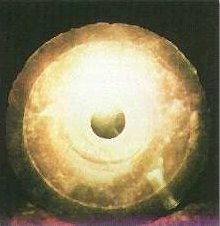
The 'Dropa' Discs refer to a cache of
small round discs (and small bodies) reportedly found in a cave on
the Chinese/Tibetan border in 1938. The story has gained the status
of a modern myth in recent times, perhaps because so many of the
integral facts of the tale remain entirely unverified.
China has long been
home to a cultural art form in which jade (stone) discs were carved
and called 'Bi Discs'. They were a status symbol, commonly found in
burials from the Neolithic period onwards. The most recent examples
were more ornately carved than those from the Neolithic.
(More
about the Dropa Discs)
(The
Longyou Caves)
(Cherchen
Man)
(The
Baigong Pipes)
(The Dropa)
(The
Chinese Pyramid Fields)
(Prehistoric
Japan)
(Prehistoric
Korea)
List and description of Polynesian sites
.
|
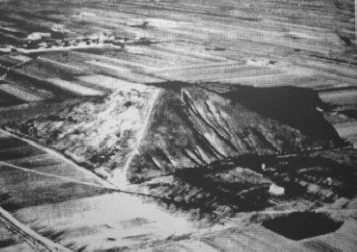
 The Baigong Cave in China
is
the location of numerous ancient underground 'metal pipes' that were
discovered in the beginning of the 20th century. Traditional
science has provided one or two explanations for their presence,
but as yet there is no definite answer as to how or why the
pipes exist where they do, as they run through the ground and
even into the nearby lake.
The Baigong Cave in China
is
the location of numerous ancient underground 'metal pipes' that were
discovered in the beginning of the 20th century. Traditional
science has provided one or two explanations for their presence,
but as yet there is no definite answer as to how or why the
pipes exist where they do, as they run through the ground and
even into the nearby lake. 

 Jiahu:
(A cache over over 30 bird-bone flutes). The 9,000-year-old flutes
are made from hollowed bird bones, and have between 5 and 8 holes.
Remarkably, one of the flutes is still playable. Scientists also
know of a 45,000-year-old, so-called Neanderthal flute made of a
hollow bear bone that was dug up in Slovenia in 1995. The Chinese
flutes are capable not just of single notes but of what we would
class as music (4)
Jiahu:
(A cache over over 30 bird-bone flutes). The 9,000-year-old flutes
are made from hollowed bird bones, and have between 5 and 8 holes.
Remarkably, one of the flutes is still playable. Scientists also
know of a 45,000-year-old, so-called Neanderthal flute made of a
hollow bear bone that was dug up in Slovenia in 1995. The Chinese
flutes are capable not just of single notes but of what we would
class as music (4) In April 2003 Dr. Garman Harbottle of the
Brookaven National Laboratory in Upton, New York,
and a team of archaeologists at the University of
Science and Technology of China, in Anhui province,
announced that signs carved into what appeared to be
8,600 year-old-tortoise shells may be the earliest
written words.
In April 2003 Dr. Garman Harbottle of the
Brookaven National Laboratory in Upton, New York,
and a team of archaeologists at the University of
Science and Technology of China, in Anhui province,
announced that signs carved into what appeared to be
8,600 year-old-tortoise shells may be the earliest
written words.




